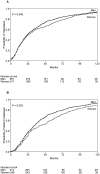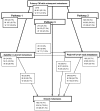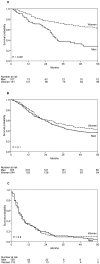Time course and pattern of metastasis of cutaneous melanoma differ between men and women
- PMID: 22412958
- PMCID: PMC3295777
- DOI: 10.1371/journal.pone.0032955
Time course and pattern of metastasis of cutaneous melanoma differ between men and women
Abstract
Background: This study identified sex differences in progression of cutaneous melanoma.
Methodology/principal findings: Of 7,338 patients who were diagnosed as an invasive primary CM without clinically detectable metastases from 1976 to 2008 at the University of Tuebingen in Germany, 1,078 developed subsequent metastases during follow up. The metastatic pathways were defined in these patients and analyzed using the Kaplan-Meier method. Multivariate survival analysis was performed using Cox modeling. In 18.7% of men and 29.2% of women (P<0.001) the first metastasis following diagnosis of primary tumor was locoregional as satellite/in-transit metastasis. The majority of men (54.0%) and women (47.6%, P = 0.035) exhibited direct regional lymph node metastasis. Direct distant metastasis from the stage of the primary tumor was observed in 27.3% of men and 23.2% of women (P = 0.13). Site of first metastasis was the most important prognostic factor of survival after recurrence in multivariate analysis (HR:1.3; 95% CI: 1.0-1.6 for metastasis to the regional lymph nodes vs. satellite/in-transit recurrence, and HR:5.5; 95% CI: 4.2-7.1 for distant metastasis vs. satellite/in-transit recurrence, P<0.001). Median time to distant metastasis was 40.5 months (IQR, 58.75) in women and 33 months (IQR, 44.25) in men (P = 0.002). Five-year survival after distant recurrence probability was 5.2% (95% CI: 1.4-2.5) for men compared with 15.3% (95% CI: 11.1-19.5; P = 0.008) for women.
Conclusions/significance: Both, the pattern of metastatic spread with more locoregional metastasis in women, and the time course with retracted metastasis in women contributed to the more favorable outcome of women. Furthermore, the total rate of metastasis is increased in men. Interestingly, there is also a much more favorable long term survival of women after development of distant metastasis. It remains a matter of debate and of future research, whether hormonal or immunologic factors may be responsible for these sex differences.
Conflict of interest statement
Figures




References
-
- Lee ML, Tomsu K, Von Eschen KB. Duration of survival for disseminated malignant melanoma: results of a meta-analysis. Melanoma Res. 2000;10:81–92. - PubMed
-
- Kolmel KF, Kulle B, Lippold A, Seebacher C. Survival probabilities and hazard functions of malignant melanoma in Germany 1972–1996, an analysis of 10433 patients. Evolution of gender differences and malignancy. Eur J Cancer. 2002;38:1388–94. - PubMed
-
- Lasithiotakis K, Leiter U, Meier F, Eigentler T, Metzler G, et al. Age and gender are significant independent predictors of survival in primary cutaneous melanoma. Cancer. 2008;112:1795–804. - PubMed
Publication types
MeSH terms
LinkOut - more resources
Full Text Sources
Medical

